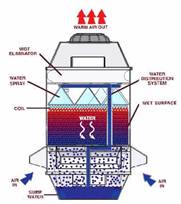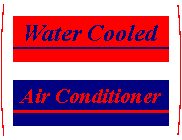|
In home / residential water cooled air conditioners uses water to remove heat from the refrigerant and reduces the work of the compressor. There are several models and designs to save energy. The Water Cooled Air Conditioner in a residential application is basically the same technology already used in commercial buildings, just down sized. |
|
Remember, air cooled conditioning units lose a large percentage of their rated efficiency at higher temperatures. Their SEER / EER ratings drop as temperatures rise. In larger cities around the world are experiencing a phenomena called the “urban heat island” effect which causes the so called “one size fits all” design to become huge energy consumers. A water cooled air conditioner has a minimal drop in efficiency and in the dryer regions the efficiency rises. Water removes heat far more efficiently than air. |
|
Ask yourself - before picking up a hot pipe - would you rather blow hot air on it or spray it with cold water? |
|
The newest water cooled Air Conditioning systems are now designed using a closed loop circuit. These home and residential units are call evaporative condenser cooling, evaporative fluid cooling, or evaporative subcooling towers. All are designed to have water cool the coils, but they are designed by utilizing the natural resources available to the installation location. In these units water cools the coils within the tower and the heat evaporation is pulled out by a fan mounted on top. |
|
Evaporative Fluid Cooling, Evaporative Condenser Cooling, and Evaporative Subcooling towers all use water to cool the refrigerant in a closed loop design. The only difference in the towers is the coil design required by application. The Evaporative Water Cool Air Conditioning Retro Fit technology is saving energy by reducing consumption and lowering carbon footprint. |
|
As much as half of the energy used in a home goes to heating and cooling. So making smart decisions about your home's heating, ventilating, and air conditioning (HVAC) system can have a big effect on your utility bills and your comfort. To increase the efficiency of an existing or a new heating and cooling system needs to be addressed. First considering the geographic location of your home is big factor to what type will be the most efficient. Utilizing the natural resources available is second. The third consideration should be the seasonal changes, which will be needed most, heating or cooling. |
|
Installing the right size equipment for any home is essential to getting the best performance and comfort. Many homeowners believe that bigger is better when buying new heating and cooling equipment. But in reality, a system that's too large will not keep your home comfortable because of frequent 'on/off' cycling. Incorrect sizing can also put stress on system components and shorten the equipment's life, in-turn will cost you more. |
|
For geothermal systems the correct design and size is essential. The largest factor is the geographic location due to the different climates. The proper geothermal loop design will by-far be the greatest energy saver. Geothermal heat pumps are similar to ordinary heat pumps, but use the ground instead of outside air to provide heating, air conditioning and, in most cases, hot water. Because they use the earth's natural heat, they are among the most efficient, comfortable heating and cooling technologies currently available. |
|
Water Cooled Air Conditioning Designs |
|
These applications are considered Green energy savers. Utilizing what is now in place and incorporating any natural resources to enhance and design a super energy efficient Water Cool Heating and Air Conditioning system. There are several designs to retro fit to any existing HVAC system. Simple Retro fit is keeping the existing Air Handler inside the home and replacing the Condenser unit outside with an Evaporative Condenser Cooling tower. Other designs use the subcooling technology, one is using an evaporative fluid cooling tower, cooling water in a close circuit with a water / freon heat exchanger connected to a compressor and keeping the existing Air Handlers inside the home. The same concept in the swimming pool application. Another is using a lake or pond with a Copper Heat Exchanger and the water / freon heat exchanger connect to a compressor, also keeping the existing Air Handlers inside. Most all existing HVAC systems can be retro Fitted into a energy saving Hybrid Water Cooling system. |
|
Considering all resources, man made or natural, can provide unique Heating and Air Conditioning designs to gain super energy efficient units. Some are known as hybrid cooling towers, these use Freon/Water Heat Exchangers to subcool refrigerant lines. One energy resource is using a swimming pool to cool the home and extend the seasons swimming pleasure. A very efficient design using what man has made for pleasure, but now converting it into an energy saving component. Another Hybrid design is using a Lake / Pond Heat Energy Exchange Coil to Heat and Cool any home or building. This design, much like the geothermal lake / pond loop, uses a special sized Copper Coil Heat Exchanger submersed in the water and a water / freon heat exchanger to cool the refrigerant. This design is also using a natural resource to save energy. |
|
Water Cooled Applications |
|
Water Cooled Air Conditioning Retro-Fits |
|
Proper Sizing of Equipment |
|
Geothermal uses water in a closed circuit ground loop design to heat and air condition a home. This application uses a ground source heat pump. Also there are several types and benefits to these designs to achieve the most energy efficient water cooled heating and air conditioning on the market today. While the designs may vary with the applications, water cooled units will always be the most efficient. |
|
To learn more on water cooling technology and products visit: Thermco Energy Systems |


